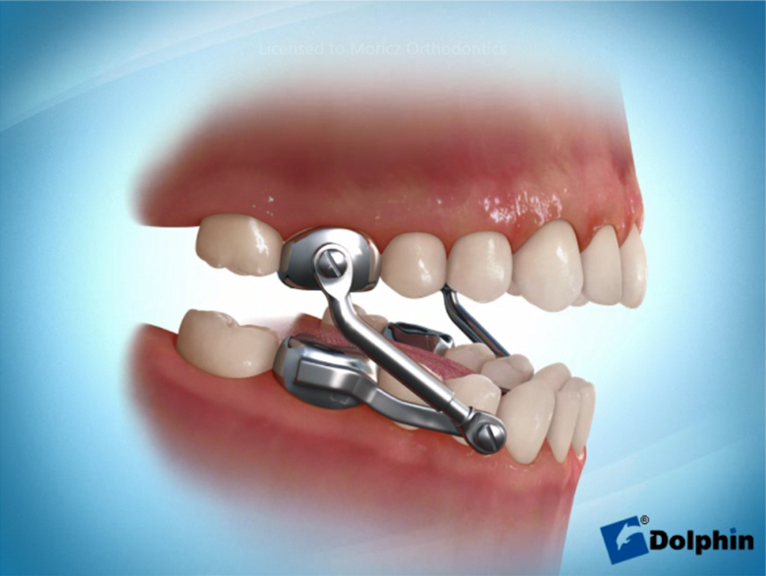The Herbst is a growth modification appliance used when the upper jaw is too far forward compared to the lower jaw. It replaces the old-fashioned headgear. It can prevent surgery and or extractions in some patients.
What is a Herbst appliance?
It consists of four stainless steel caps that fit over the back molars – one in each corner of your mouth. The top portion of the appliance consists of an expander (to learn more about the expander, click here) ExpanderVideoMoriczOrthodontics or looped wire which runs along your palate. The lower portion has two metal bars that run parallel to the outer sides of your lower back teeth and a thin bar that runs along the inner sides of your lower teeth for stability. Two metal cylinders or ‘arms’ connect the top and bottom. The appliance is glued (with orthodontic cement) into the patient’s mouth and typically stays in your mouth for 9-12 months once the arms are placed.
How Does the Herbst Work?
The Herbst may seem like a large appliance, but it does many amazing things to improve your bite and jaw harmony. The appliance connects a top appliance, usually an expander, with a bottom piece and a system of metal caps and ‘arms’ or cylinders to connect the top and bottom jaw. All the pieces work together to correct a severe overjet (commonly mis-referred to as an overbite and also known in slang as ‘buck-toothed’). Many think the Herbst corrects the overjet by moving the lower jaw forward, and while this does happen, it is the sum of 5 movements created by the Herbst appliance that corrects the jaw relationships. The five movements are: 1) the expander portion widens the upper jaw, allowing room for teeth to move to a broader smile position rather than stick out or, put another way, move from a V-shaped upper jaw to a U-shape; 2) the top jaw moves back; 3) the bottom jaw moves forward; 4) the top teeth move back, and 5) the bottom teeth move forward. These movements take 9-12 months and work with growth to improve the facial and dental relationships.

What to Expect with a Herbst
The Herbst is a big appliance because it does a big job. It can prevent extractions and even surgery in many patients. It’s an amazing appliance, but it does take time to get accustomed to. Be patient and give it time.

- The Herbst appliance will feel a little bulky at first. Most patients get used to it after the first week.
- It takes a few days for the mouth to toughen up, so if the appliance irritates any areas of your cheeks or gums, cover the part of the Herbst that’s bothering you with wax to act as a cushion. You can also mix ½ teaspoon of salt with eight ounces of warm water and swish the solution in your mouth as needed.
- If you find that you talk a little funny or it feels strange to swallow during the initial days of wearing the Herbst, don’t avoid these activities. You will get used to it, but to speed things up, read aloud, talk on the phone a lot and keep swallowing. Don’t spit
- Not everyone needs expansion but if you do, follow the specific instructions we give you. If your teeth or jaws get a little sore when you turn the expansion screw, take the appropriate dose of an over-the-counter pain reliever like Advil or Tylenol.
- You may feel like you ‘can’t’ eat or chew. You can and have to eat a well-balanced diet, but to start, ensure you have soft foods at home, and protein shakes are a great addition to ensure you get adequate nutrition. Also, be sure to drink plenty of water. You tend to drink less when you eat less, and we don’t want you to dehydrate. You will become used to chewing with your appliance soon! Hang in there!
- Make sure to brush and Waterpik around your appliance; food and plaque can hide in all the nooks and cause gum disease and bad breath, it can also be uncomfortable if food or plaque gets trapped on or around your soft tissue or teeth.
